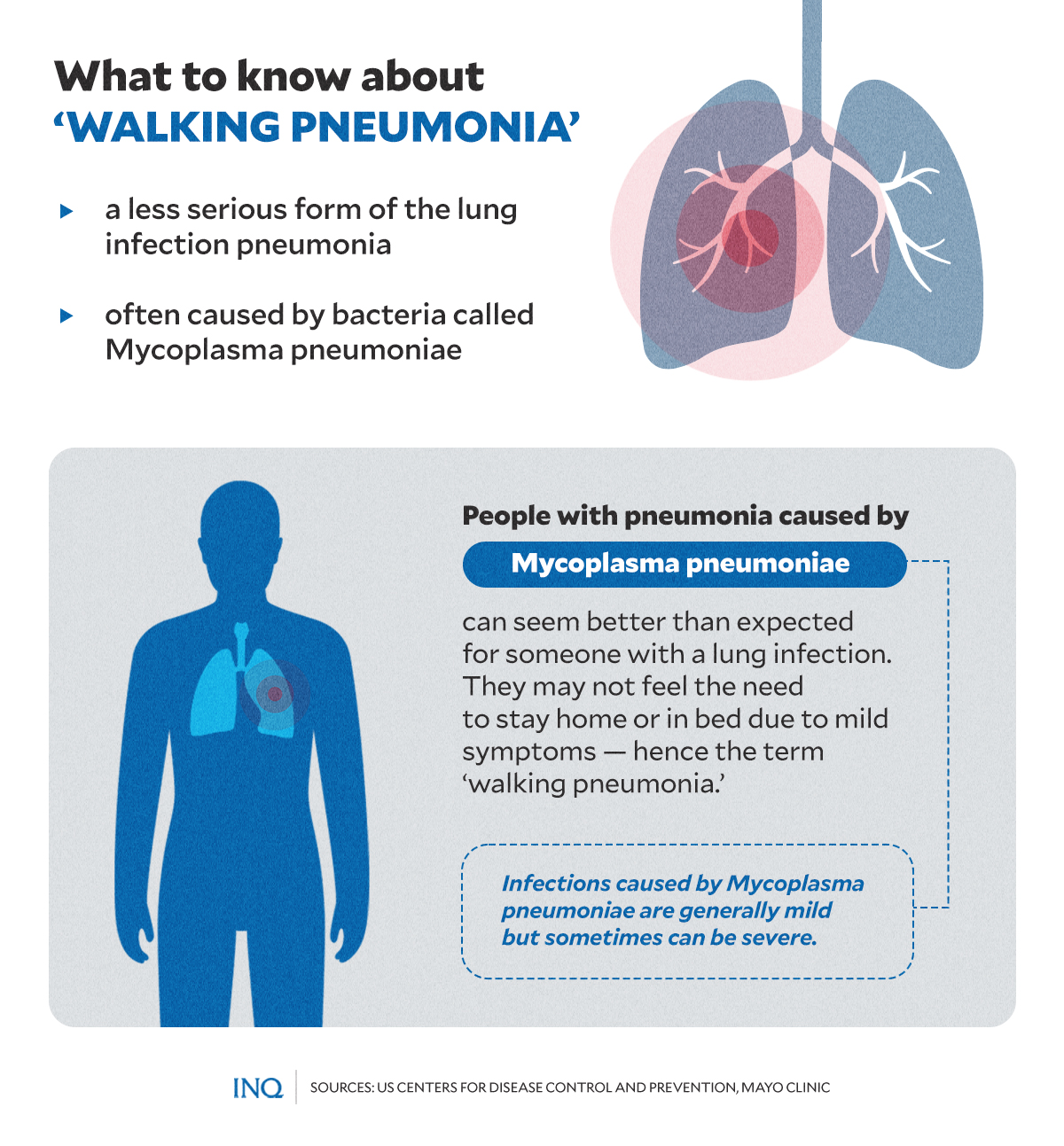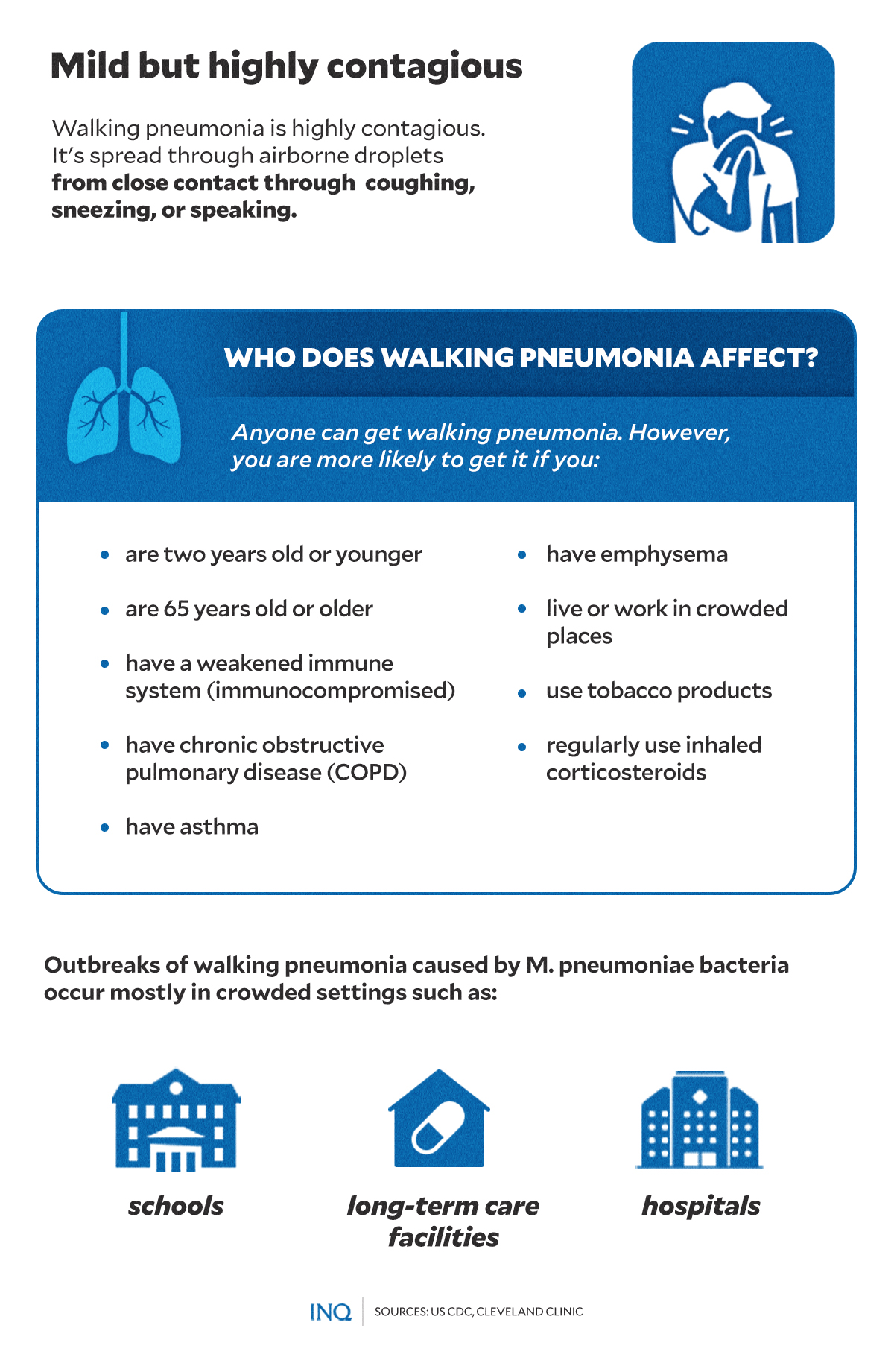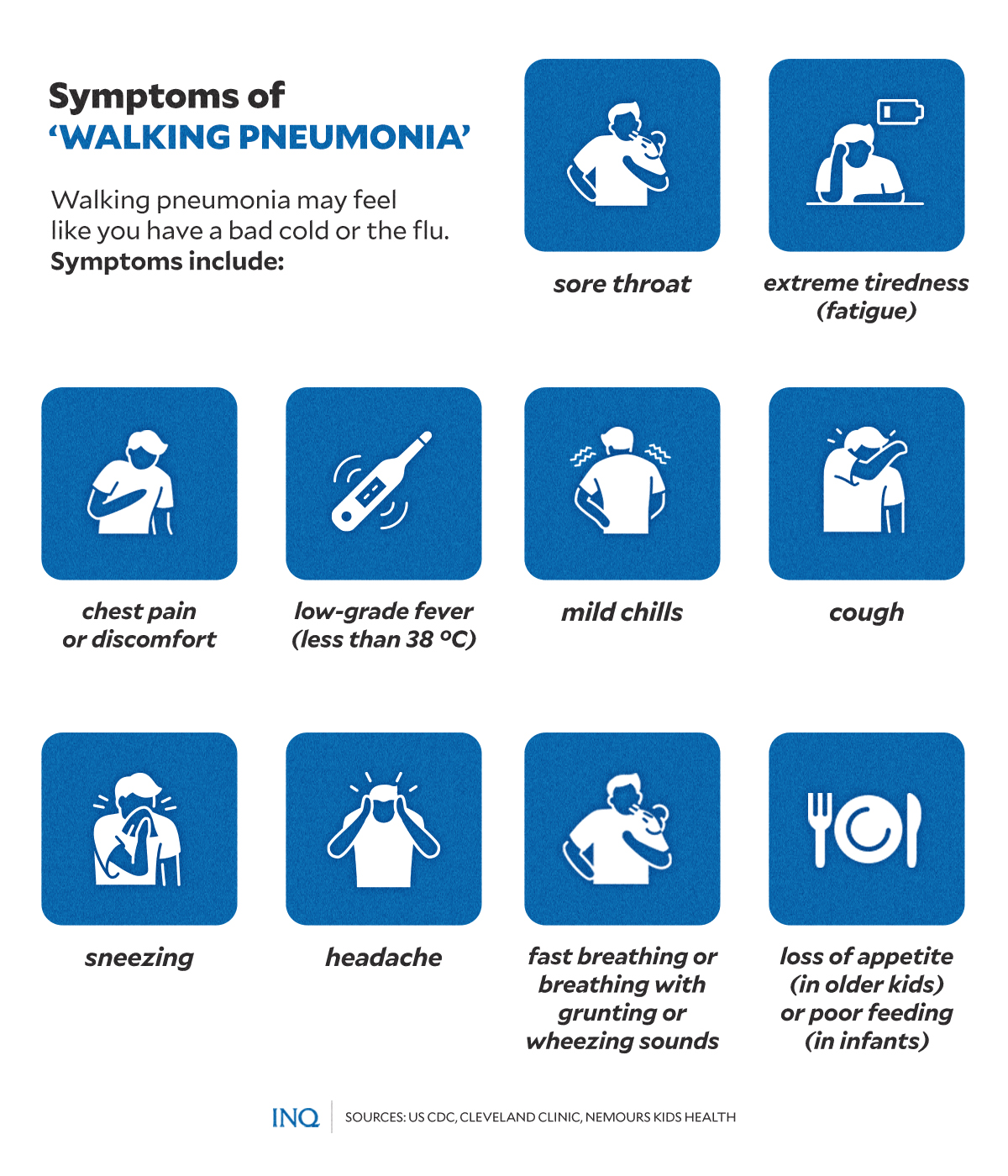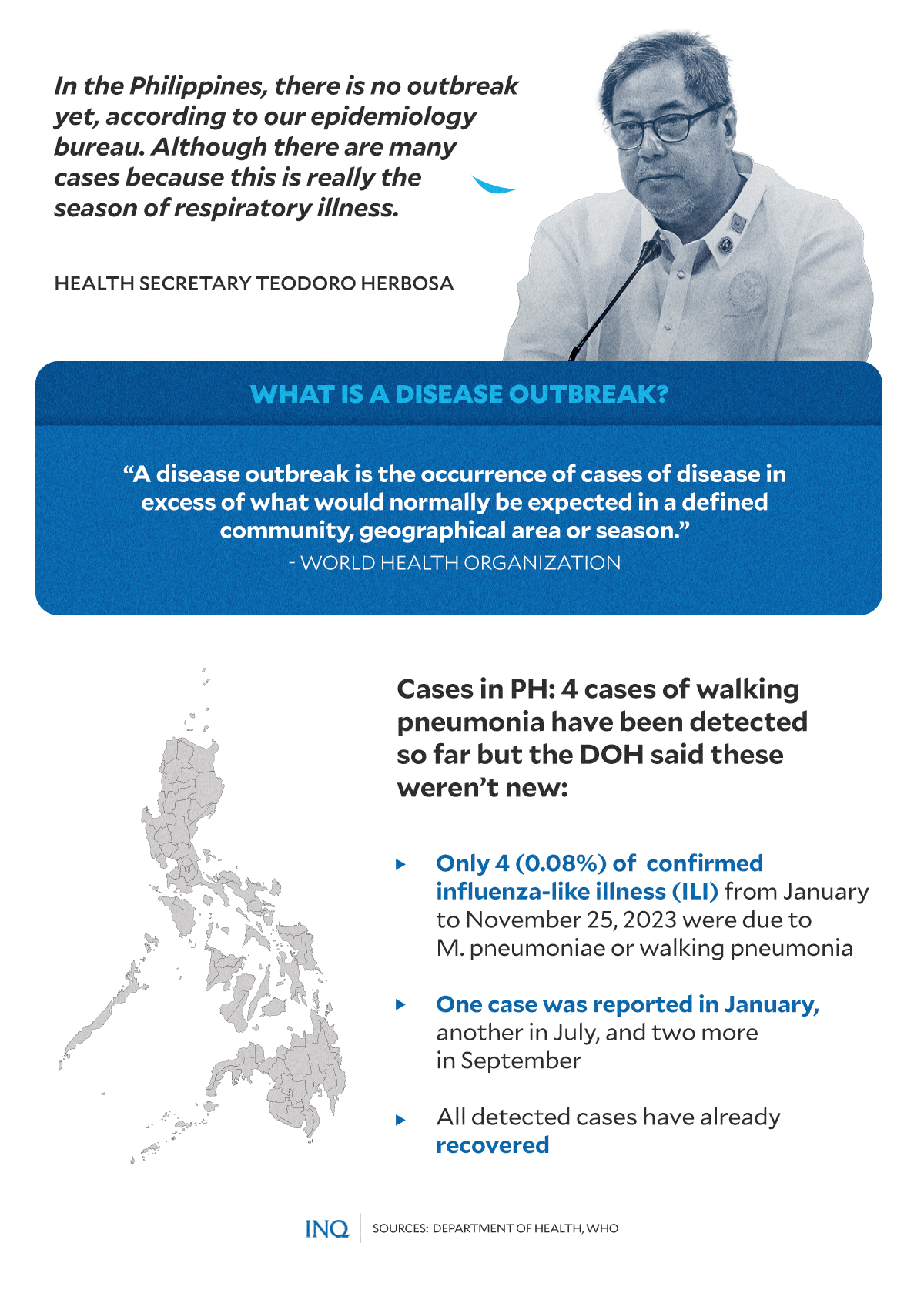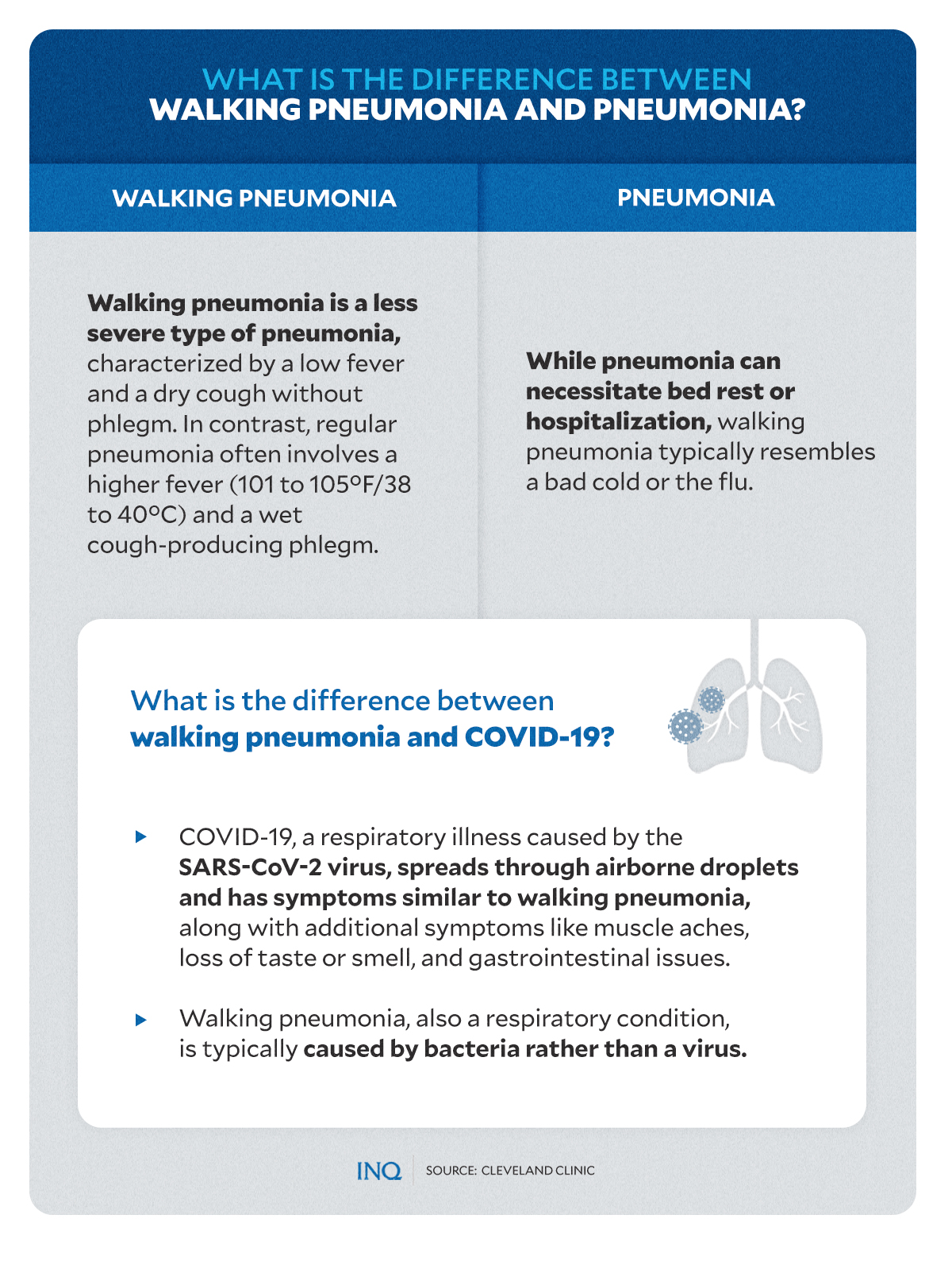Amid growing concerns, health experts allay fears over ‘walking pneumonia’
MANILA, Philippines—As the health department’s recent confirmation of cases of “walking pneumonia” in the country amid the outbreak of respiratory illness in China has raised concerns and questions among the public; medical experts, in contrast, are actively working to alleviate these fears.
The question comes up: Why are they focused on trying to calm these public worries?
Earlier last month, Chinese authorities from the National Health Commission reported an increase in the incidence of respiratory diseases—such as pneumonia—among children in China.
According to a statement released by the World Health Organization (WHO), Chinese authorities attributed the surge of infections to the “lifting of COVID-19 restrictions, the arrival of the cold season, and due to circulating known pathogens.”
Chinese authorities also reported that since May, there has been a rise in hospital admissions of children, especially in northern cities like Beijing. These were attributed mainly to Mycoplasma pneumoniae, a bacterium that infects the lungs and often leads to “walking pneumonia,” a typically mild form of the illness that usually doesn’t need bed rest or hospitalization.
Article continues after this advertisementREAD: China: surge in respiratory illnesses caused by flu, known pathogens
Article continues after this advertisementWHO and several medical experts across the globe are not too worried about the current outbreak in China, noting that the uptick was expected and that other countries saw similar increases in respiratory diseases after the lifting or easing of pandemic measures.
However, this does not stop growing concerns among people worldwide, including those in the Philippines.
On Nov. 29, Health Secretary Teodoro Herbosa allayed fears of a similar surge in respiratory illness in the Philippines, stressing that the health care system is prepared should there be a sudden rise in such infections.
“I want to tell the people: Don’t be worried. We’re doing our own surveillance. In the Philippines, there’s been no reported rise of respiratory illnesses,” Herbosa assured the public.
In a statement issued by DOH that same day, the agency reiterated: “[T]here is no need for alarm; the government prioritizes the safety of the Filipino people. We will remain vigilant and provide the necessary updates for the public’s information.”
READ: DOH chief allays fears amid reports of respiratory illnesses in China
However, despite the government agency’s efforts, the public has yet again raised and expressed concerns and questions following the confirmation that the country has had cases of Mycoplasma pneumoniae, or walking pneumonia — the same illness that has been sending thousands of Chinese children to hospitals in the past months.
What we know about PH cases
In a statement, the DOH on Dec. 6 confirmed that four cases of walking pneumonia have been recorded in the country.
According to the health department, the reported infections were detected among individuals who had influenza-like illness (ILI). It added that out of the four cases, one was reported in January, another in July, and two more were confirmed in September.
READ: DOH reports four cases of ‘walking pneumonia’
In a separate statement, DOH stressed that the confirmed cases of walking pneumonia were not new, and that all four individuals who have been infected have already recovered.
“[T]he DOH wishes to clarify and emphasize that the detected cases are NOT NEW. Only 4 (0.08%) of the confirmed ILI cases from January up to November 25, 2023 were due to M. pneumoniae or ‘walking pneumonia’,” DOH said.
“All these cases have recovered,” it added.
No need to worry?
While news of confirmed cases of walking pneumonia drew concerns among some, health experts reminded the public that Mycoplasma pneumoniae—the bacterium that causes walking pneumonia—is not a new pathogen.
“Mycoplasma pneumoniae is a known and common pathogen. It causes different infections, including colds and pneumonia. It is one of the [ILIs], which presents as fever, sore throat, and cough,” the DOH said in a statement.
“Filipino doctors and medical personnel in our hospitals can treat M. pneumoniae, and have medicines for it,” it added.
Mycoplasma pneumoniae is just one of the bacteria that can cause walking pneumonia, aside from viruses and molds.
According to WHO, Mycoplasma pneumoniae is a common bacterial infection that usually affects younger children. The US Centers for Disease Control and Prevention (CDC) noted that mild infections caused by the bacteria can be treated with antibiotics.
“Here in the Philippines, the DOH has previously detected M. pneumoniae using various methods. DOH surveillance systems are able to detect ILIs and can confirm through laboratories what may be causing them,” said the DOH.
“The DOH reassures the public that detecting M. pneumoniae is NOT new or unusual,” it added.
“So far, the only country that has recorded incidents of Mycoplasma pneumoniae is China,” the health department said in a previous statement, reiterating that walking pneumonia is not a notifiable disease.
READ: DOH reports 4 confirmed cases of ‘walking pneumonia’
Meanwhile, Rontgene Solante, infectious disease expert and president of the Philippine College of Physicians, told the public that there is no need to worry about the recorded cases of walking pneumonia.
“[W]alking pneumonia is a bacterial infection, it is self-limited meaning after 7 to 10 days—or at most two weeks—with cough, you will just recover. Unlike with influenza or COVID-19, a lot of times, especially for the vulnerable populations like the elderly or those with comorbidities, it can lead to complications,” Solante said in a television interview.
“I think we really need to tone down the panic or fear that the walking pneumonia is increasing,” Solante added.
“It is expected. These are the months that we see a lot of respiratory illnesses, whether it’s bacterial or viral. We just need to wear our face masks. We need to be very cautious,” he continued.
What to look out for
Solante noted that walking pneumonia caused by Mycoplasma pneumonia can only cause mild symptoms. These include:
- sore throat
- extreme tiredness (fatigue)
- chest pain or discomfort
- low-grade fever (less than 38 °C)
- mild chills
- cough
- sneezing
- headache
- fast breathing or breathing with grunting or wheezing sounds
- loss of appetite (in older kids) or poor feeding (in infants)
Cleveland Clinic, a US-based academic medical center, said walking pneumonia may feel like having a “bad cold or the flu.”
However, since the symptoms are usually mild, those infected may not feel the need to stay home or in bed. They may be out walking around despite experiencing the symptoms; hence the term “walking pneumonia”—US-based Mayo Clinic explained.
Mild but contagious
While walking pneumonia may cause only mild symptoms, it is still very contagious.
“Walking pneumonia is contagious. It’s spread through airborne droplets from close contact, such as coughing, sneezing, or speaking,” the Mayo Clinic explained.
“People with lowered immunity may get more severely ill. You can be contagious long after you no longer have symptoms,” it added.
Walking pneumonia may also lead to possible complications such as a more severe form of pneumonia, worsening of asthma symptoms, swelling and irritation of the brain or “encephalitis,” and hemolytic anemia.
Meanwhile, for Mycoplasma pneumoniae, the CDC said most outbreaks occur in crowded settings like schools, long-term care facilities, and hospitals.
In the Philippines, the health secretary assured the public that there is no outbreak of walking pneumonia.
READ: No outbreak of ‘walking’ pneumonia in PH, says Herbosa
“In the Philippines, there is no outbreak yet, according to our epidemiology bureau. Although there are many cases because this is really the season of respiratory illness,” said Herbosa.
Solante, meanwhile, said there is no need to issue travel advisories and border controls amid recorded cases of walking pneumonia in the country, as well as the rising cases of ILIs in different countries.
The infectious disease expert added that there is still no need to implement mandatory use of face masks.
“I think at this point it’s not advisable or recommended yet to [implement] mandatory use of face masks because the cases are still manageable, even the hospitalization of this common [ILI] is not so alarming,” he said.
“We still don’t see the scenario that we experienced with COVID,” he said.
However, Solante also noted that individuals among the vulnerable population should wear face masks, especially when going out or attending gatherings during the holiday season.
Know the difference
When differentiating walking pneumonia from typical pneumonia, among the symptoms to look out for are low fever and dry cough or a cough that does not produce phlegm.
Pneumonia has a high fever (101℉ to 105℉ or 38℃ to 40℃) and a cough that produces phlegm (wet or productive cough),” Cleveland Clinic noted.
“If you have pneumonia, you may require several days of bed rest or even hospitalization. Walking pneumonia feels like a bad cold or the flu,” it added.
While walking pneumonia is a respiratory illness like COVID-19, its most common cause is a type of bacteria, not a virus. COVID-19, on the other hand, is caused by a virus called SARS-CoV-2.
“[COVID-19] spreads through respiratory droplets in the air and shares many of the same symptoms as walking pneumonia. However, it may also cause muscle and body aches, loss of taste or smell, diarrhea and nausea, and vomiting,” said Cleveland Clinic.
Prevent walking pneumonia
According to the Cleveland Clinic, there are different ways that can help prevent walking pneumonia, such as:
- covering nose and mouth with a tissue when sneezing or coughing
- sneezing or coughing into the inside of the elbow or sleeve when a tissue is not available
- regularly washing hands with soap and water for at least 20 seconds or using an alcohol-based hand sanitizer
- wearing face mask around sick people if you have a respiratory condition (such as asthma) or other chronic health conditions (including diabetes, heart or liver or kidney diseases) as these conditions can make walking pneumonia riskier for you
- getting an annual flu shot
- by not smoking and not allowing others to smoke around you
“We need to advise the public, especially during this month [and] during the gatherings this Christmas season, to be careful when going out or when attending parties and gatherings,” said Solante.
“As much as possible… if they have symp they have to stay home and rest,” he added.
Meanwhile, Dr. Harold Henrison Chiu, an endocrinologist, reminded the public to mask up.
“Mask up guys. While we have effective antibiotics against Mycoplasma and other atypicals, the severity of pneumonia may still vary depending on the immune status and comorbidities,” Chiu posted on X, formerly known as Twitter.
“When you add other viral illnesses: COVID-19, flu, RSV (Respiratory syncytial virus) to the equation, it can become severe and fatal,” he added.
For more news about the novel coronavirus click here.
What you need to know about Coronavirus.
For more information on COVID-19, call the DOH Hotline: (02) 86517800 local 1149/1150.
The Inquirer Foundation supports our healthcare frontliners and is still accepting cash donations to be deposited at Banco de Oro (BDO) current account #007960018860 or donate through PayMaya using this link.

